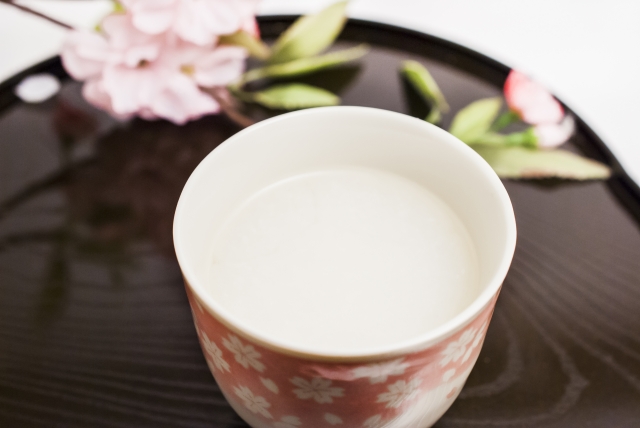What kind of Drinks Can you buy only in Japan?
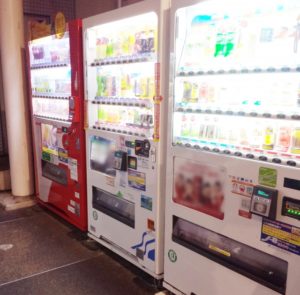
When you stop by vending machines or convenience stores, you will find shelves full of colorful, nicely, but uniquely packaged drinks. Japanese convenience stores and vending machines have all sorts of drinks from refreshing tea to sweet soda to satisfy you and also offer a bit of surprise.
Since canned, bottled, or paper-packed beverages got ubiquitous in Japan, beverage companies have improved the quality of every single drink and invented unique drinks that have never existed before. Also, universal drinks such as Fanta are sold with a subtle Japanese essence. The followings are 17 drinks you can find only in Japan.
15 Drinks You can find only in Japan
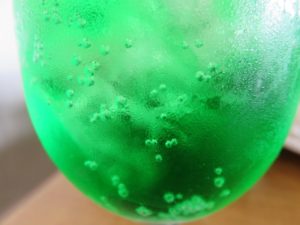
1. Ramune

Ramune is a type of carbonated soft drink created more than 120 years ago. The name “ramune” was derived from an English word “lemonade,” leading to the original flavor of ramune, lemon-lime. It has been a representation of summer due to its refreshing flavor and see-through bottles, and enjoyed by all generations.
Ramune is known to be its specially designed bottles, the idea of which was from Hiram Codd. They are made of glass and sealed with a marble, with the pressure of the carbonation in the bottle keeping the marble at the head. When you drink ramune, you push the marble inward with a device provided. People who try ramune for the first time have difficulties to open it because sometimes the drink splashes out once you push the marble inward. Empty bottles are usually collected and recycled.
2.Mitsuya Cider
Mitsuya Cider is a carbonated soft drink invented in 1884, now sold and produced by Asahi. Although it is named “cider,” it is used in a different meaning from that used in English. “Cider” in Japanese refers to a carbonated drink with a cross flavor between Sprite and Ginger Ale. But Asahi comes out additional flavors such as grapes, orange, peach, lemon, and peach. Seasonally limited versions are also produced annually.
Originally Mitsuya Cider was sold in metal bottles but is now mostly sold in plastic bottles. Old metal bottles can be found in some places and those who like to feel a sense of nostalgia favor that type of Mitsuya Cider.
3. Flavored Fanta
Of course, Fanta is an American soft drink, but Japanese Fanta has so many different kinds of flavors which you cannot find in other parts of the world. More than 100 kinds of flavors have come out since Fanta arrived in Japan, which makes it No.1 brand in the fruit-flavored carbonated soft drink category in Japan.
Other than familiar flavors like grape and orange, Japanese Fanta includes white peach, melon, honey lemon, yuzu (citrus fruit), grapefruit, pineapple, strawberry, muscat, Japanese pear, white banana, tropical mango, fruit punch, golden apple….and many more.
Japanese Fanta releases new flavor every year, which keep fans attracted.
4. Japanese tea
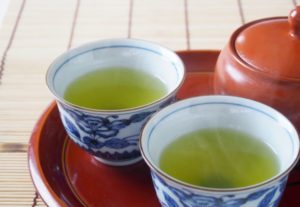
Green tea is a part of everyday life in Japan. Since the arrival of green tea from China in the 8th century, the Japanese have been enjoying tea. They often drink tea after the meal, and restaurants, convenience stores, and vending machines always have a variety of tea. Some regions such as Kyoto and Shizuoka specialize in green tea cultivation as their local specialties. Green tea is known to have a lot of health benefits like anti-cancer, anti-virus, anti-oxidation, and so forth.
The followings are types of tea that are familiar to Japanese daily lives.
-Sencha
Sencha is what people usually call green tea or ryokucha. It is abundant in caffeine, catechin, and vitamin C. Different companies have different brands on sencha, so shelves at convenience stores are filled with a lot of bottled sencha.
-Houjucha
Houjucha is made with sencha leaves dry-roasted until turning brown. People adore its savory aroma and taste, which makes it the best drink after the meal. Also, Houjicha contains less caffeine and catechin; it can be enjoyed by many generations from small kids to elderlies.
-Genmaicha
Genmaicha is made with dry-roasted brown rice and sencha. Genmaicha fills your mouth with the savory flavor of roasted brown rice and refreshing fragrance. Same as houjucha, genmaicha includes little caffeine.
Tea is sold in the form of either tea leaves or bottled, but most people buy bottled tea at convenience stores or vending machines. If you want to make tea from tea leaves, you want to find your favorite type of tea and get a Japanese teapot. If you are away from Japan, you can, of course, buy them online.
5. Calpis
Calpis, also known as Calpico outside of Japan, is a non-carbonated soft drink sold by Calpis Co., Ltd. It has a milky, slightly acidic flavor and tastes like a middle of yogurt and milk. It is made from water, nonfat dry milk and lactic acid produced by lactic acid fermentation.
Calpis is sold both as a concentrate or as a diluted version. The concentrate version is usually found at supermarkets and mixed water just before drinking. Varieties of fruit flavor are produced, so some people send a set of flavored calpis as a gift. The diluted version is often found in convenience stores and vending machines, and a common choice for the young.
6. Pocari Sweat
PocaRi sweat is a Japanese non-carbonated soft drink marketed in 1988, and was a starting block of spreading sports drink across Japan. Though many consider this beverage as a sports drink, the manufacturer Otsuka Pharmaceutical Co., Ltd. does not label it as such. Otsuka sells Pocari sweat as a “health drink,” which replenishes quickly water and ions to the human body.
Aquarius from Coca-Cola Japan is a rival product. While Aquarius has more sour flavor, Pocari sweat has more sweet flavor.
7. Match
Match is a light-carbonated soft drink produced by Otsuka Pharmaceutical Co., Ltd. Marketed as “Vitamin carbonated drink,” Match contains some kinds of vitamins like vitamin 6, C, and niacin. It is yellow-colored which evokes Gatorade or Vitamin Water, and tastes like those beverages. It is sold in various sizes, from 270 ml of plastic bottles to 1.5L of plastic bottles. The grapefruit flavor is also available.
8. Canned coffee
Japanese office workers are mostly so busy that they do not have time to stop by a cafe and grab a cup of coffee. That is why canned coffee is one of the main drinks that takes a large space of shelves at stores, and is affordable for everyone due to its low price ($1).
Different companies produce various types of coffee brands like BOSS from Santory, Georgia from Coca-Cola, WONDA from Asahi, and so on. The beverage companies have a wide range of line-up from espresso to cafe au lait to match each customer’s preference.
But you may be doubtful about the quality of the canned coffee. Well, that is your task to taste both canned coffee and coffee from Starbucks. Let’s see how much they are different!
9. Yakult
Yakult is a probiotic drink produced by Yakult Honsya Co. It contains water, skimmed milk powder, sugar, flavors, and live Lactobacillus casei Shirota strain, and has a milky, yogurt-like flavor tasting similar to Calpis. Yakult is notable for the live Lactobacillus casei Shirota strain, which reaches the intestine and helps it keep in good condition. Some schools serve Yakult for school lunch valuing those health benefits.
10. Hachimitsu-Lemon (Honey Lemon)
Hachimitsu-Lemon is a soft drink flavored with lemon and honey. Hachimitsu-Lemon is available throughout the year but is usually considered to be a drink for the wintertime. As many people get sick easily in winter, hachimitsu-lemon, which is rich in vitamin C would help them prevent from getting sick. Candies with hachimitsu-lemon are also sold at stores.
11. Amazake
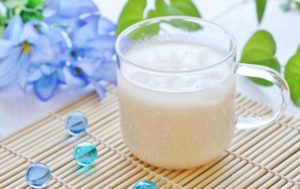
Amazake is a traditional Japanese beverage made with rice yeast and rice. Although it is named amazake (sweet alcoholic beverage), it contains little alcohol, so amazake is categorized into the soft drink.
The origin of amazake is considered to be back in the mid-third century, and was consumed as a nutrition drink because of its nutritious value. Today, many shrines and temples offer amazake to visitors on the new year’s day. Some regions still keep traditions of making amazake as an offering to express the gratitude of good harvest.
Amazake comes in canned, binned, powdered, and freeze-dried. It is available at convenience stores or vending machines but is sometimes served at shrines and temples.
12. Flavored soy milk
Soy milk is known to be a healthy, nutritious option instead of cow’s milk, which attracts health-conscious customers. Did you know that the Japanese soy milk comes in more than 50 varieties in flavor?
Despite its nutritious value, some people do not like soy milk due to its strong smell and taste from which you feel soybeans directly. Various companies have released flavored soy milk so that it reduces the strong flavor of soybeans and makes it easier to drink.
Regular flavors include plain, banana, chocolate, tea, and coffee. Plus, soy milk producers release seasonal version in each season. They try to make the flavor match the image of the season and also try to include familiar Japanese taste. For example, in spring, sakura (cherry blossom) flavor comes out. Customers can feel a sense of spring by finding it at food stores. Common Japanese flavors contain oshiruko, green tea, amazake, Japanese plum, and so on. Tasting those flavors will be a great way to experience Japanese taste.
13. Aloe drink
Aloe drink is made with either only the juice or with the juice and the pulp of the aloe vera plants. As well as its health benefits like anti-inflammatory and antiseptic properties, the slightly sweet, refreshing flavor makes it popular. Usually, aloe drink contains only aloe flavor, some variations mix chopped aloe pulps with fruit flavor-based soft drinks such as muscat. But as aloe drink usually contains a lot of sugar, you may want to opt for sugar-free aloe drink if you want to appreciate its health benefits.
14. Jelly drink
You may wonder what jelly drink is. It is literally a drinkable jelly. Crushed jelly is packed in a squeezable pouch with a plastic nozzle, and can be re-sealed with a plastic cap. So you don’t have to finish it up once you open. The pouch can be held with one hand, which makes it portable and easier to drink. Flavors vary, but usually contain fruit flavors such as orange, lemon, grape, or peach. Drinks which contain various nutrients are also popular, for they come in handy to refill lacked nutrients.
Jelly drinks are available at any types of stores, including supermarkets, convenience stores, drug stores, and some vending machines.
15. See-through drink
You might have thought, “another weird drink comes up again,” but see-through drink is basically a flavored water. You may have flavored water in your country, but Japanese flavored water goes beyond your imagination.
Fruit-flavored water had already been available and popular in Japan, but Suntory, a large beverage company, blew a new wind into the flavored water. In 2015, Suntory launched a new product called “Yogurina,” which is water with yogurt flavor. It seems to taste awful, but in fact, it was sold out within three days from the release. In 2017, the same company produced “Premium morning tea lemon,” which is water flavored with lemon tea.
Unique flavored water is definitely worth a try if you are craving for an exciting experience in Japan!
Japanese Drinks; Just Give it a Go!

Did you find any drinks you want to try?
I hope those drinks will make your experiences in Japan even more enjoyable and interesting!
See you next time!
